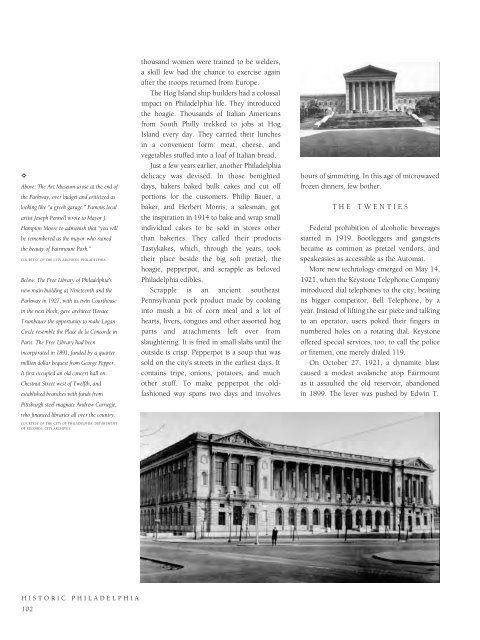Historic Philadelphia
An illustrated history of the city of Philadelphia, paired with the histories of companies, families and organizations that make the region great.
An illustrated history of the city of Philadelphia, paired with the histories of companies, families and organizations that make the region great.
You also want an ePaper? Increase the reach of your titles
YUMPU automatically turns print PDFs into web optimized ePapers that Google loves.
✧<br />
Above: The Art Museum arose at the end of<br />
the Parkway, over budget and criticized as<br />
looking like “a greek garage.” Famous local<br />
artist Joseph Pennell wrote to Mayor J.<br />
Hampton Moore to admonish that “you will<br />
be remembered as the mayor who ruined<br />
the beauty of Fairmount Park.”<br />
COURTESY OF THE CITY ARCHIVES, PHILADELPHIA.<br />
Below: The Free Library of <strong>Philadelphia</strong>’s<br />
new main building at Nineteenth and the<br />
Parkway in 1927, with its twin Courthouse<br />
in the next block, gave architect Horace<br />
Trumbauer the opportunity to make Logan<br />
Circle resemble the Place de la Concorde in<br />
Paris. The Free Library had been<br />
incorporated in 1891, funded by a quarter<br />
million dollar bequest from George Pepper.<br />
It first occupied an old concert hall on<br />
Chestnut Street west of Twelfth, and<br />
established branches with funds from<br />
Pittsburgh steel magnate Andrew Carnegie,<br />
who financed libraries all over the country.<br />
COURTESY OF THE CITY OF PHILADELPHIA, DEPARTMENT<br />
OF RECORDS, CITY ARCHIVES.<br />
thousand women were trained to be welders,<br />
a skill few had the chance to exercise again<br />
after the troops returned from Europe.<br />
The Hog Island ship builders had a colossal<br />
impact on <strong>Philadelphia</strong> life. They introduced<br />
the hoagie. Thousands of Italian Americans<br />
from South Philly trekked to jobs at Hog<br />
Island every day. They carried their lunches<br />
in a convenient form: meat, cheese, and<br />
vegetables stuffed into a loaf of Italian bread.<br />
Just a few years earlier, another <strong>Philadelphia</strong><br />
delicacy was devised. In those benighted<br />
days, bakers baked bulk cakes and cut off<br />
portions for the customers. Philip Bauer, a<br />
baker, and Herbert Morris, a salesman, got<br />
the inspiration in 1914 to bake and wrap small<br />
individual cakes to be sold in stores other<br />
than bakeries. They called their products<br />
Tastykakes, which, through the years, took<br />
their place beside the big soft pretzel, the<br />
hoagie, pepperpot, and scrapple as beloved<br />
<strong>Philadelphia</strong> edibles.<br />
Scrapple is an ancient southeast<br />
Pennsylvania pork product made by cooking<br />
into mush a bit of corn meal and a lot of<br />
hearts, livers, tongues and other assorted hog<br />
parts and attachments left over from<br />
slaughtering. It is fried in small slabs until the<br />
outside is crisp. Pepperpot is a soup that was<br />
sold on the city’s streets in the earliest days. It<br />
contains tripe, onions, potatoes, and much<br />
other stuff. To make pepperpot the oldfashioned<br />
way spans two days and involves<br />
hours of simmering. In this age of microwaved<br />
frozen dinners, few bother.<br />
THE<br />
TWENTIES<br />
Federal prohibition of alcoholic beverages<br />
started in 1919. Bootleggers and gangsters<br />
became as common as pretzel vendors, and<br />
speakeasies as accessible as the Automat.<br />
More new technology emerged on May 14,<br />
1921, when the Keystone Telephone Company<br />
introduced dial telephones to the city, beating<br />
its bigger competitor, Bell Telephone, by a<br />
year. Instead of lifting the ear piece and talking<br />
to an operator, users poked their fingers in<br />
numbered holes on a rotating dial. Keystone<br />
offered special services, too; to call the police<br />
or firemen, one merely dialed 119.<br />
On October 27, 1921, a dynamite blast<br />
caused a modest avalanche atop Fairmount<br />
as it assaulted the old reservoir, abandoned<br />
in 1899. The lever was pushed by Edwin T.<br />
HISTORIC PHILADELPHIA<br />
102
















